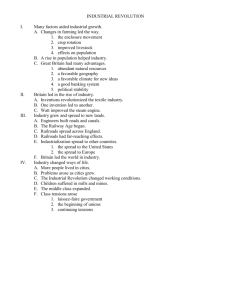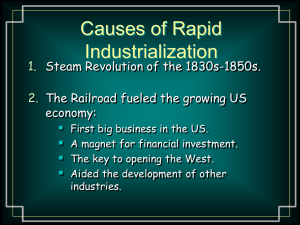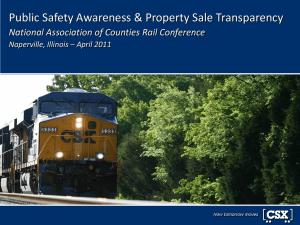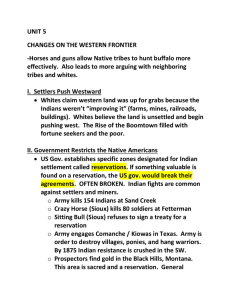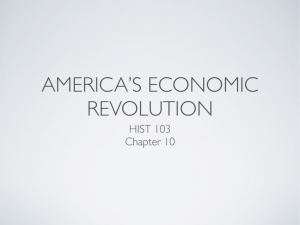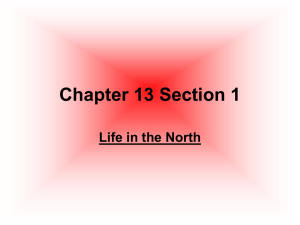Chapter 12 - Prong Software
advertisement
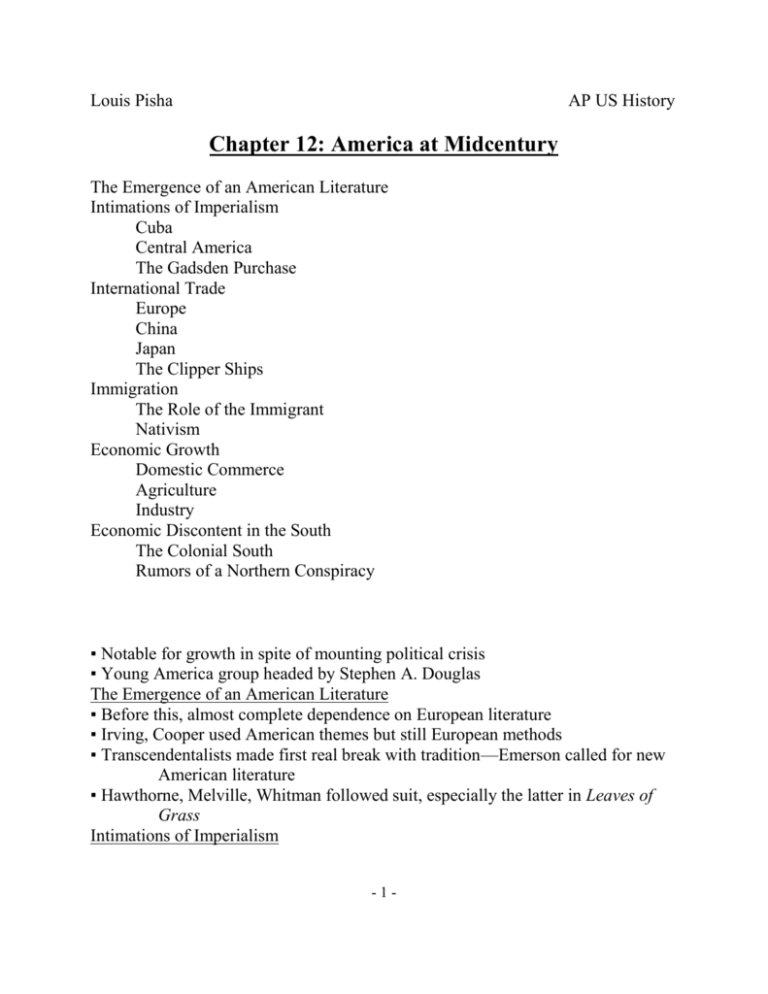
Louis Pisha AP US History Chapter 12: America at Midcentury The Emergence of an American Literature Intimations of Imperialism Cuba Central America The Gadsden Purchase International Trade Europe China Japan The Clipper Ships Immigration The Role of the Immigrant Nativism Economic Growth Domestic Commerce Agriculture Industry Economic Discontent in the South The Colonial South Rumors of a Northern Conspiracy ▪ Notable for growth in spite of mounting political crisis ▪ Young America group headed by Stephen A. Douglas The Emergence of an American Literature ▪ Before this, almost complete dependence on European literature ▪ Irving, Cooper used American themes but still European methods ▪ Transcendentalists made first real break with tradition—Emerson called for new American literature ▪ Hawthorne, Melville, Whitman followed suit, especially the latter in Leaves of Grass Intimations of Imperialism -1- ▪ Pierce said Manifest Destiny not complete—implied eventually take over Mexico and Canada ▪ Some looking to Cuba, Central America, Hawaii Cuba ▪ South hoped to acquire it to increase power and prevent British—also strategic importance ▪ After Mexican War, pro-annexation sentiment so strong offered to buy it for $100 million ▪ Pierce sent Soulé to Spain to get it and conferred with Mason (France) and Buchanan (Britain)—recommended (Ostend Manifesto) that US benefit from Cuba, Spain better off without it ▪ However, crisis it precipitated caused Pierce to repudiate it ▪ Became a sectional issue when antislavery Northerners didn’t want it annexed Central America ▪ US signed treaty with Colombia which gave US transit rights through Panama in exchange for guarantee of Colombia’s control over it ▪ Walker (American) seized control of Nicaraguan government three times and driven out, finally executed ▪ Competition with Britain for canal (Britain claimed Mosquito Islands at one end of a prospective canal) ▪ Treaty signed between us that any canal either of us built would be free to everyone, open in war, no colonization in Latin America (ClaytonBulwer Treaty) ▪ Although prohibited further Am expansion down, not a bad bargain The Gadsden Purchase ▪ War Department looked for routes of a transcontinental railroad, and the only that would work in the South would pass through Mexico (so northern route would be chosen) ▪ Davis persuaded Gadsden to buy strip of land for $10 million—established present-day borders of continental US International Trade Europe ▪ Economic recovery after 1837 caused carrying trade to be profitable NE ▪ South still supplied cotton to Britain; Britain became market for Am wheat; low tariffs; huge rise in immigration ▪ 2/3 commerce with Europe—Am crops for British manufactured goods ▪ Cotton still major export crop ▪ US imported more than exported, but had gold in California to offset China -2- ▪ 5% Am trade with Asia by 1860—many merchants dazzled by profits—Canton biggest port ▪ When Britain gained advantages, Tyler sent Cushing to China and in Treaty of Wanghia, got extraterritoriality and “most favored nation” treatment Japan ▪ Japan tried to maintain a feudal society so very little trade—we wanted their markets and assured safety if ships crashed ▪ Fillmore sent Perry to Japan with letter—returned to Japan negotiated these terms and “most favored nation” treatment ▪ Harris first US consul—tried to get Japan to industrialize before it suffered the same fate as China The Clipper Ships ▪ Griffith designed Rainbow as first clipper ship—broke records for speed ▪ Gave US even larger share of carrying trade—3 months around Horn of South America ▪ Panama Railroad and Canal made them obsolete, as well as steam vessels— British again became more profitable carriers Immigration The Role of the Immigrant ▪ 1830-1860, population almost tripled, but still in need of workers and farmers for Western lands ▪ Decline in native-born population, but immigration huge ▪ Majority still from N and W Europe—Irish potato famine brought tons, suppression of 1848 revolution in Germany brought refugees ▪ Most through NY but some elsewhere ▪ No program to help them so got cheated ▪ Irish tended to congregate in slums and factories, Germans moved west ▪ Few settled in South because slavery ▪ Contributed to culture and did necessary labor for country, including farming, mining, factories, artisans, railroaders Nativism ▪ Came from concern about number of immigrants, but also felt immigrants pollute Anglo-Saxon stock of country, crime in slums, burden on public funds, economic competitors at lower wages, political power (always voted Democrat) ▪ Strongest force: anti-Catholicism—immigrants almost always Catholic and Americans almost always Protestant—fear grew out of bigotry, temporal power of Catholic Church, and disagreement over doctrine -3- ▪ Believed immigrants sent by Pope to destroy Protestantism, and accounts of immorality within church—incited anti-Catholic riots ▪ Nativist societies sprang up and joined to form Order of the Star Spangled Banner (Know-Nothings)—secret society to defend Protestantism, restrict immigration laws, increase naturalization years, and deprive aliens of vote ▪ More and more people joined, and not just Whigs ▪ 1856, formed American party, nominated Fillmore, and won 22% popular vote ▪ After this, declined—only success was Massachusetts made English bible required to be read, and elsewhere complete failure ▪ Also, secrecy supposedly cloaked conspiracy—they failed to destroy idea of America as refuge for persecuted Economic Growth ▪ Labor force doubled, more workers in factories and less in agriculture, abundance of raw materials, spread of factory system, more machines ▪ Trend toward modernization Domestic Commerce ▪ Internal trade expanded to exchange agriculture for manufactured ▪ Much moved along waterways, but canals diverted traffic from Miss to Great Lakes—connected Ohio River with Lake Erie, Mississippi with Lake Michigan ▪ NY replaced New Orleans as chief outlet ▪ Also, competition from railroads: 1830 first part of B&O railroad open -to- by 1860, 30,627 miles of trackage ▪ Originally, railroads connected small towns to water—later, network consolidated that bypassed the water, but largely in NW and NE ▪ Funds came from private investors and state subsidies ▪ Railroads linked Ohio and Miss with Great Lakes, and gone as far west as St. Joseph, Missouri ▪ Congress passed railroad land grant bill in Illinois—by 1860, 28 million acres of public land given to railroads ▪ Transcontinental railroad brought up, but route was a sectional question, so firms established transcontinental stagecoaches, later pony express ▪ Then put out of biz by telegraph—by 1861, communication from E to W in minutes Agriculture ▪ Farmers went to cities, lands sold to more profitable sheep farmers ▪ NE farmers turning to fruits, vegetables, and cows -4- ▪ South grew cotton, tobacco, sugar—center of S shifted W and great profits being made ▪ Non-slaveholding small farmers stayed self-sufficient for the most part ▪ Old NW became meat, wheat, and corn production center ▪ Farm mechanization: steel plow, mechanical reapers ▪ Agriculture more of a biz enterprise, which is good for investors but some farmers didn’t like it Industry ▪ 1850s higher growth than any other decade—market almost entirely domestic ▪ Most involved processing products of farms and forests—milling, etc ▪ Most manufacturing enterprises quite small ▪ Textile manufacturing core of New England, also vulcanization of rubber, sewing machines, iron manufacturing for locomotives ▪ Because of not enough labor, turned out precision, interchangeable parts ▪ Corporation form spread ▪ Crafts felt threatened by machines—employers began to think of employees as slaves to be bought for lowest price—ignored min wage, child labor laws, industrial accidents ▪ Reformers usually urged workers to go out West and seldom approved of trade unions ▪ Commonwealth v. Hunt ruled that labor unions were not conspiracies, so they increased but when struck often ran into trouble ▪ By 1860, trade unionism had emerged, but not successfully Economic Discontent in the South The Colonial South ▪ Southern cotton played less of a role in economy—replaced by industry ▪ Economies based on agriculture and very little manufacturing ▪ South tried (Convention at Augusta) to establish trade directly with Europe, steamship lines, and railroads, but not achieved ▪ Despite tries to start industry, agriculture more prosperous in S Rumors of a Northern Conspiracy ▪ Believed victims of N conspiracy planned by economists and their political goons ▪ Not only did N profit from free economy, plot with government to sectional advantage ▪ South considered a colony to the North (by Southerners)—what’s important is that they thought this, not if it was true (it wasn’t) -5-
